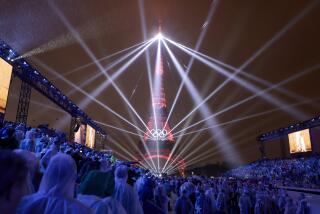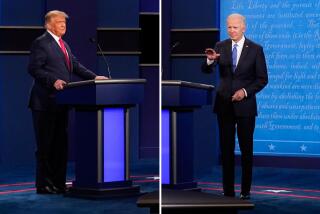Networks Map Strategy for Covering Summit
- Share via
NEW YORK — After a week of showing viewers dramatic images of the “human face” of political change in Eastern Europe, from candlelit demonstrations in downtown Prague, Czechoslovakia, to a meeting in Rome between Pope John Paul II and Soviet leader Mikhail Gorbachev, the TV networks this weekend will face a new challenge: depicting diplomacy aboard two ships floating in the scenic Mediterranean.
When President Bush and Soviet President Gorbachev meet to discuss the roles of their two nations at a time of sweeping change in the world, their summit meeting will take place in a tightly controlled environment: two warships, the U.S. cruiser Belknap and the Soviet ship Slava, anchored in the bay off the coast of Malta.
“There will be interesting pictures to look at,” says Jeff Gralnick, the ABC News executive in charge of the network’s special coverage. “But summits are not picture stories. This is a talking-head story.”
The three major broadcast networks, plus Cable News Network, will anchor their evening newscasts from Malta tonight, continuing with live coverage throughout the Saturday-Sunday “Saltwater Summit.”
To provide live coverage from the two ships, the networks will use microwave dishes that will transmit TV signals to a receiver on shore, where they will be beamed up to each network’s satellite in New York. American and Soviet navy launches will periodically ferry camera crews and correspondents from the shore onto the ship to report on the talks. (The network anchors--who have logged many miles with their coverage from Europe over the past few weeks--are likely to stay ashore to broadcast from the networks’ own facilities on Malta.)
A major storm could affect the microwave signal, but, says Gralnick, “The bay is large and protected from the heavy seas. In some ways, this is less difficult logistically than covering the Reagan-Gorbachev summit in Reykjavik, Iceland, where we were all focused on a little white house” where the talks were conducted.
More of a challenge will be offering early analysis of the summit talks, which begin at 12:30 a.m. Pacific time. With the co-stars in the drama initially sequestered aboard the ships, notes Lane Vernardos, director of the CBS News special-events unit, “This isn’t exactly the White House briefing room.”
Correspondents will be “working the phones,” says Vernardos, and debriefing Soviet and American officials as events unfold.
Originally planned only a few weeks ago as a get-acquainted session between the two world leaders, the Malta summit has assumed more significance with the avalanche of change in Eastern Europe.
In addition to the networks’ own anchors and correspondents, experts who can provide analysis of the East Bloc, possible nuclear-arms topics and other areas are sought after as guests on the newscasts. In addition to academics and guests such as former U.N. Ambassador Jeane Kirkpatrick, CBS, in the new spirit of glasnost , has hired an expert from the Soviet Union, Sergei Plekhanov, as a consultant to analyze the talks from the Soviet perspective.
“Our plan is to pair Plekhanov with an expert from Princeton, who will be able to separate any mis- or dis-information--not that we expect any,” says Vernardos. In addition to coverage throughout the day Saturday, the networks will provide live coverage of Bush’s and Gorbachev’s respective press conferences on Sunday. They will offer extended versions of their early-morning news programs such as NBC’s “Sunday Today,” CBS’s “Sunday Morning” and ABC’s “This Week With David Brinkley.”
Cable News Network will have updates “virtually every hour” during the two days on its regularly scheduled newscasts, according to Jane Mitchell, the CNN executive in charge of the special coverage for the cable-news channel.
Some TV critics have criticized the networks’ new emphasis on having the anchor fly to the scene of a major story such as the summit, saying that the message to viewers is that, like a tree falling in the forest, a story doesn’t exist unless it’s covered by Dan Rather, Peter Jennings, Tom Brokaw or Bernard Shaw.
“One of the responsibilities of the media is to set the agenda for the country in terms of what is and isn’t important,” says Joe Angotti, senior vice president of news at NBC. “TV does that with the anchor. When we send an anchor, it places the story on the nation’s agenda.”
More to Read
Sign up for Essential California
The most important California stories and recommendations in your inbox every morning.
You may occasionally receive promotional content from the Los Angeles Times.












